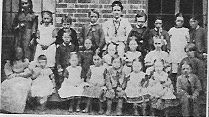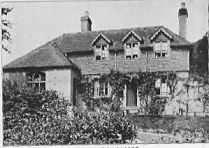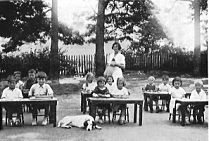Edward Hussey of Scotney initiated the building of an infants’ school at Riseden. He became owner of Finchcocks in 1865 and he resolved to use a small endowment of income from land at Horsmonden, gifted by a predecessor Thomas Bathurst of Finchcocks, for his purpose.
Thomas Bathurst had died in 1718 and in his Will he directed that certain lands in Horsmonden, being a part of the Finchcocks estate, be held in trust and the income from that land was “to be paid by the Trustees to a nominated poor person in Goudhurst at the rate of £5 per annum, who would teach the poor children living at Riseden Quarter or Kilndown, to read and write”.
Viscount Beresford of Bedgebury, who had died in 1854, had also left a sum of £100 a piece to Kilndown, Goudhurst, Hawkhurst and other neighbouring parishes, to be paid to relieve the poor of those parishes. The Trustees of this endowment in Kilndown had been wise and invested the capital sum and then provided fuel and food to the poor in the winter months using only the interest. Their aim was to ensure that funds would be available for the foreseeable future, rather spending it all at once, as had happened in Goudhurst.
Edward Hussey gave the land for the new school and made a generous subscription to the building fund. Rev. Henry Harrison, vicar at Christ Church, Kilndown, and William Campion of Combwell made donations and the offertory on Advent Sunday at Christ Church also added to the fund.
In addition, grants were received from the National and Diocesan Education Societies and, in 1868 work on construction of the new school began. Robert Norris, clerk of the works at Bedgebury, was responsible for the design of the building and supervision of the work. Tenant farmers in the local area carried building materials to the site free of charge.
An infants’ schoolhouse with one schoolroom and living accommodation for the mistress was completed at Riseden in 1868. The schoolroom measured; length – 28 feet, breadth – 16 feet, and height – 14 feet.
The dedication ceremony took place on 3 December 1868 and the school opened four days later. Its purpose was to educate children up to the age of 6 years. Each child was required to pay two pence per week but any other children of the same family attending at the same time, or any child transferring from Kilndown School, would only have to pay one penny per week. Applications for admission were to be made to the vicar of Kilndown, Rev. Henry Harrison.
Pupil attendance numbers fluctuated considerably. In the winter months heavy rain or snowfall would see a sharp reduction in attendance numbers. In April 1878 the School’s log book entry reads “Not one present today owing to the weather”. In January 1880 an entry reads “A very snowy morning. Only twelve present” and in March 1891 it reads “No children came on Wednesday morning. Three came in the afternoon, the snow plough having cleared the roads”.
Another frequent cause of reduced numbers was illness. In 1890 the school was closed for six weeks owing to an outbreak of influenza. It was closed for three weeks in 1893 and for four weeks in 1901 during outbreaks of measles. Illness among these young children was very common. Complaints appearing in the school log books included; measles, mumps, scarlet fever, diphtheria, whooping cough, influenza, chicken pox and ‘English’ cholera. English cholera, according to an inquest held at the Kilndown School, was the cause of death of two young pupils, Charles Waghorn aged 4 years 9 months and his sister Anna Louisa aged 7 years 8 months, who died at home within a day of each other. Both children were buried at Kilndown Church on 9 January 1909. The school was often closed for days or weeks at a time when these ‘common illnesses’ of the period were prevalent.
At Christmas time the school was given a Christmas tree and a tea was provided for the children. For several years each child received a Christmas card from Miss Harrison, the vicar’s daughter. School closed just before Christmas, often on Christmas Eve, and reopened in early January – weather permitting. Wives and daughters of notable local families would often visit the school to perhaps hear the children read or listen to them sing or recite.
In June 1878 the school fee was raised from twopence to threepence per child per week. However, from September 1891 the Elementary Education Act provided for free education with the state paying the fees by way of a grant. In 1893 a damming report by the School Inspector said Riseden pupils “are listless and inattentive and are backward in almost all respects”. He said the school was ineffective and issued a formal warning that the school’s grant may be withheld at the next annual inspection if there was no improvement. The Mistress, Emily Layton, resigned. The following year the Inspector reported that “The children are making really good progress under their present Mistress (Annie Evans). The school is now in first rate order, the children are bright and attentive”. Mrs Evans only served as Mistress from February to October 1894, when Mrs Woolgar took the position; Mrs Evans continued as assistant teacher. Despite Mrs Evans’ hard work during her few months as Mistress, the amount of government grant paid to the school was halved in 1895 because she was not fully qualified.
While at the school the children were expected to ‘learn their numbers’ and to read and write. In addition the girls were to be taught knitting and needlework. But this was often not the case. In December 1894 the entry in the school’s log book reads “Not one girl at the school has been taught knitting, and their needlework is very bad. First class can only read words of two letters and cannot put down their numbers beyond ten”.
In 1937 Kent Education Committee (KEC) recommended to the School Managers that the Riseden infants be transferred to the existing Kilndown School. The School Managers believed this was the best option for the children and agreed to KEC’s proposals. New classrooms, cloakrooms, a playground and a new house for the headmistress were be built at Klndown all of which, it was hoped, would attract ‘an up-to-date and capable’headmistress. Riseden School was closed and the children transferred to their new classrooms at Kilndown School from November 1937.
The Schoolhouse was subsequently sold and is today a private residence.
Headmistresses at Riseden School included Rachel Clapson (1868 – 1890) , Emily Layton (1890 – 1893), Annie Evans (1894), Mrs A Woolgar (1894 – 1918), Miss Mary D Woolgar (assistant teacher from 1905 and temporarily took over from her mother), Miss Stream (1918 – 1922) and Miss Snell. Mrs Nora Wyborn was the last headmistress serving until the school closed in 1937.



